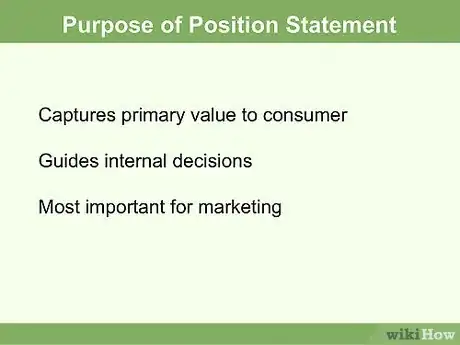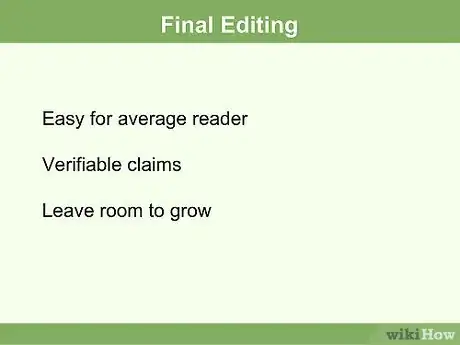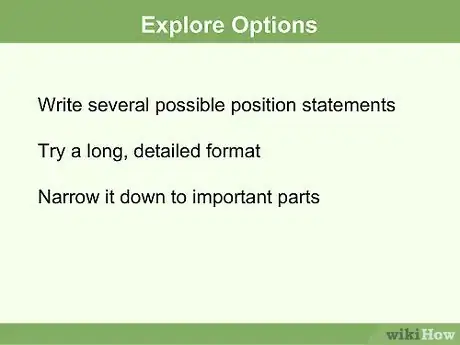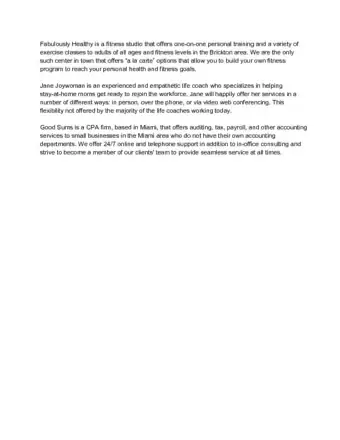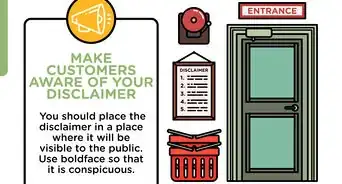This article was co-authored by Anna Colibri. Anna Colibri is a Digital Marketing Specialist and the CEO of Colibri Digital Marketing in the San Francisco Bay Area. Anna specializes in branding, digital strategy, product and service development, team management, and leadership development with a focus on women and minority business owners and professionals. Anna holds a Bachelor's degree in Sociology from The University of California, Davis, and a Master's degree in Social Welfare from The University of California, Berkeley. Colibri Digital Marketing is San Francisco’s first B Corp certified digital marketing agency. They won the 2019 Better Business Bureau Torch Awards for Ethical Business, the 2009 Local Excellence Award, and one of the Best Digital Marketing Agencies in San Francisco in 2017.
This article has been viewed 332,565 times.
The organization you work for is gearing up to launch a new product or program, or to enter into a new market. As a member of the marketing team, it’s your job introduce the new product to clients and to brand the new product. The positioning statement acts as a reference document for any branding activity you do at your organization for a new product. You can also use the positioning statement to communicate with the marketing services partners you will work with (advertising agency, designers, media buying, web marketing, consultants, etc.) to launch the new product.[1]
Steps
Understanding the Purpose of a Positioning Statement
-
1Treat your positioning statement like an internal tool for your company. The positioning statement should encapsulate the primary value of the product or service for the consumer. All your product and marketing decisions for your company brand should align and support your positioning statement. It will act like a roadmap for your company’s marketing team and serve as a guidepost for all your marketing plans.[2]
- A positioning statement is a great way for different employees to understand your brand, whether it's an intern, your social media team, or a new hire.[3]
-
2Identify the target market for the product in the positioning statement. Your positioning statement should also identify the target market for the product and how you are going to market the product to that target market.
- Every product has a “value proposition”, which means how much the product is worth to its intended consumer. Your positioning statement should be able to communicate the value proposition of the product and provide a strategy for marketing the product based on its value proposition.
Advertisement -
3Go for a simple, memorable, and specific position statement. Your positioning statement should be written for the average reader and be easy to understand and remember. It should also be written specifically for your target market and make claims that are within reason. Your brand or company should be able to deliver on the promises and commitments made in the position statement.[4]
- As well, a good position statement will demonstrate how your company will differentiate from other companies and competitors. Your company should be able to “own” its position in the market with this new product, while still being consistent with its existing branding and marketing plan.
- A good position statement will also leave room for your brand or company to grow into its position in the marketplace. The position statement shouldn’t be a closed statement, and should be looking to the future growth of your company, as well as any adjustments or changes that may be made moving forward.[5]
- Try to outline the purpose of your brand with a vivid description that really grabs people emotionally.[6]
Creating a Positioning Statement
-
1Define your ideal customer, or your target market. Ask yourself what types of businesses or consumers you want to reach and what their interests are.[7] Consider how your ideal customer or your target market are influenced and how they make their decisions. Try to be as specific as possible.[8]
- For example, if you are marketing a new baby product you may target middle-upper class expectant mothers. If you are marketing a protein supplement for healthy weight gain, you may target men ages 24-40.
-
2Note the unique value your company offers. What makes your company or brand stand apart from the other competitors? Think about the services your company offers that you are most proud of or confident in, and how this provides a certain value for your customers.
- For example, you may be able to provide the lowest prices for a new baby product, or the highest quality protein supplements in the market.[9]
-
3Show your company’s value to the customer. Once you’ve identified your target audience, or customer, as well as your unique value, you need to then provide evidence to back up your claims. You need to get your customer to believe in your company’s ability to prove its value and follow through on its marketing promises.
- For example, you may note that your company eliminates costly overhead by only selling the new baby product online. Or you may note that you have a unique partnership with producers to sell only the highest quality protein supplements.
- It’s important to only claim as much as you can prove or follow through on. Don’t make exaggerated or unreasonable value claims, such as, “we will match any other price you find online”, if your company or brand is not willing to actually commit to this claim and follow through on it.
-
4Use a standard template to create your position statement. Most position statements follow the same template: For [insert Target Market], the [insert Brand] is the [insert Point of Differentiation] among all[insert Frame of Reference] because [insert Reason to Believe].[10]
- The point of differentiation (POD) should describe how your brand or new product will help your customers in ways that distinguish you from your competitors.
- The frame of reference (FOR) is the category or segment in the market where your company competes with other companies.
- The reason to believe should be a compelling phrase that gives your customer a reason to believe in your claims.
- For example, Amazon’s position statement is: For World Wide Web users who enjoy books, Amazon.com is a retail bookseller that provides instant access to over 1.1 million books.
- Note that Amazon identifies its target market, places its brand up front, inserts the market it is operating in, and notes how it will follow through on its claim.
- Another example is Volvo’s position statement: For upscale American families, Volvo is the family automobile that offers maximum safety.
- This is a less specific position statement than the Amazon statement, but it still communicates Volvo’s brand. Volvo notes its target market, inserts its operating market, and includes how the brand will make consumers believe it’s claim.
-
5Create your brand or company position statement. Look at the position statement examples, as well as the template and create several possible position statements for your company. Say you are trying to market a new baby toy. Your target market may be middle to upper class expectant mothers, you are marketing for the baby toys sector, and you feel your product is unique because it is sold exclusively online at a low price and offers educational value as well as recreational play for mother and child.
- Your initial position statement may be long and detailed. For example: For middle to upper class expectant mothers, BabaTots is a baby toy that offers fun and engaging play for mother and child, at an affordable price point and only available online.
- You may then streamline your first try so the statement is concise and clear. For example: For middle to upper class expectant mothers, BabaTots is an interactive baby toy that provides educational value and recreational play for mother and child at an affordable price point.
- Try to include your brand's tagline, mottos, hashtag, research, elevator pitch, and various links of description in your statement.[11]
Sample Positioning Statements
Community Q&A
-
QuestionWhat is mandatory to include if I just want a barebones positioning statment?
 Anna ColibriAnna Colibri is a Digital Marketing Specialist and the CEO of Colibri Digital Marketing in the San Francisco Bay Area. Anna specializes in branding, digital strategy, product and service development, team management, and leadership development with a focus on women and minority business owners and professionals. Anna holds a Bachelor's degree in Sociology from The University of California, Davis, and a Master's degree in Social Welfare from The University of California, Berkeley. Colibri Digital Marketing is San Francisco’s first B Corp certified digital marketing agency. They won the 2019 Better Business Bureau Torch Awards for Ethical Business, the 2009 Local Excellence Award, and one of the Best Digital Marketing Agencies in San Francisco in 2017.
Anna ColibriAnna Colibri is a Digital Marketing Specialist and the CEO of Colibri Digital Marketing in the San Francisco Bay Area. Anna specializes in branding, digital strategy, product and service development, team management, and leadership development with a focus on women and minority business owners and professionals. Anna holds a Bachelor's degree in Sociology from The University of California, Davis, and a Master's degree in Social Welfare from The University of California, Berkeley. Colibri Digital Marketing is San Francisco’s first B Corp certified digital marketing agency. They won the 2019 Better Business Bureau Torch Awards for Ethical Business, the 2009 Local Excellence Award, and one of the Best Digital Marketing Agencies in San Francisco in 2017.
Digital Marketing Specialist So, you need the "big idea" front and center, which is what it is that your brand stands for and does. You also need to include your audience, vision, mission, and promise to your customers. Things like your tagline, motto, and elevator pitch are generally good to include as well.
So, you need the "big idea" front and center, which is what it is that your brand stands for and does. You also need to include your audience, vision, mission, and promise to your customers. Things like your tagline, motto, and elevator pitch are generally good to include as well. -
QuestionIs there a template I should follow for this?
 Anna ColibriAnna Colibri is a Digital Marketing Specialist and the CEO of Colibri Digital Marketing in the San Francisco Bay Area. Anna specializes in branding, digital strategy, product and service development, team management, and leadership development with a focus on women and minority business owners and professionals. Anna holds a Bachelor's degree in Sociology from The University of California, Davis, and a Master's degree in Social Welfare from The University of California, Berkeley. Colibri Digital Marketing is San Francisco’s first B Corp certified digital marketing agency. They won the 2019 Better Business Bureau Torch Awards for Ethical Business, the 2009 Local Excellence Award, and one of the Best Digital Marketing Agencies in San Francisco in 2017.
Anna ColibriAnna Colibri is a Digital Marketing Specialist and the CEO of Colibri Digital Marketing in the San Francisco Bay Area. Anna specializes in branding, digital strategy, product and service development, team management, and leadership development with a focus on women and minority business owners and professionals. Anna holds a Bachelor's degree in Sociology from The University of California, Davis, and a Master's degree in Social Welfare from The University of California, Berkeley. Colibri Digital Marketing is San Francisco’s first B Corp certified digital marketing agency. They won the 2019 Better Business Bureau Torch Awards for Ethical Business, the 2009 Local Excellence Award, and one of the Best Digital Marketing Agencies in San Francisco in 2017.
Digital Marketing Specialist There are certainly templates you can find online, but you don't have to use them. Feel free to play around with your statement and make it your own. It should showcase your personality, so don't be afraid to get a little inventive here!
There are certainly templates you can find online, but you don't have to use them. Feel free to play around with your statement and make it your own. It should showcase your personality, so don't be afraid to get a little inventive here!
References
- ↑ http://blog.ecornell.com/how-to-write-market-positioning-statements/
- ↑ http://blog.ecornell.com/how-to-write-market-positioning-statements/
- ↑ Anna Colibri. Digital Marketing Specialist. Expert Interview. 29 June 2021.
- ↑ http://www.business2community.com/marketing/value-proposition-101-write-positioning-statement-01129772
- ↑ http://blog.ecornell.com/how-to-write-market-positioning-statements/
- ↑ Anna Colibri. Digital Marketing Specialist. Expert Interview. 29 June 2021.
- ↑ Anna Colibri. Digital Marketing Specialist. Expert Interview. 29 June 2021.
- ↑ http://blog.ecornell.com/how-to-write-market-positioning-statements/
- ↑ http://blog.ecornell.com/how-to-write-market-positioning-statements/
- ↑ http://www.business2community.com/marketing/value-proposition-101-write-positioning-statement-01129772
- ↑ Anna Colibri. Digital Marketing Specialist. Expert Interview. 29 June 2021.
About This Article
To write a positioning statement, find the target audience for the product or service you are trying to support. Then, find a simple, clear way to tell that audience why your product is different from and better than what your competitors are offering. While you’re writing, try to avoid making unreasonable claims, and try to provide as much evidence for you claims as possible. For tips on how to revise your positioning statement, read more!
